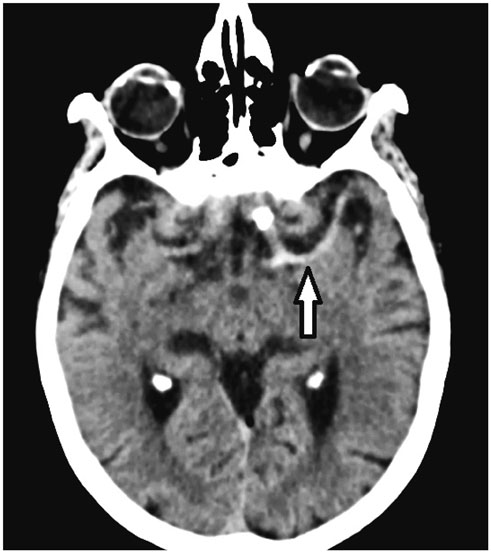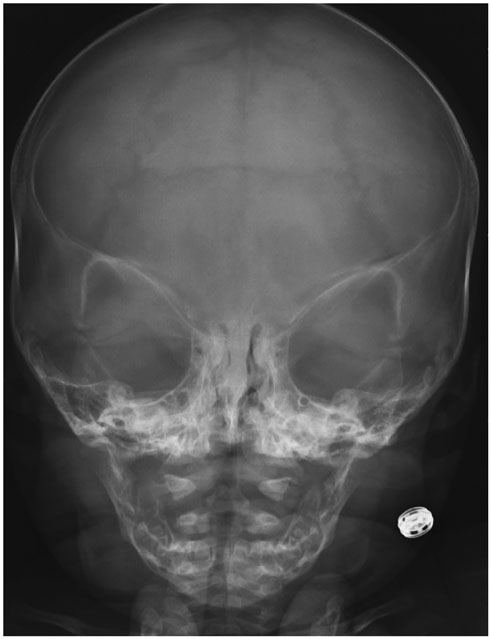Korean J Radiol.
2017 Dec;18(6):992-1004. 10.3348/kjr.2017.18.6.992.
Signs in Neuroradiology: A Pictorial Review
- Affiliations
-
- 1Department of Radiology, Akdeniz University Faculty of Medicine, Antalya, Turkey. alpoztek@gmail.com
- KMID: 2427209
- DOI: http://doi.org/10.3348/kjr.2017.18.6.992
Abstract
- One of the major problems radiologists face in everyday practice is to decide the correct diagnosis, or at least narrow down the list of possibilities. In this context, indicative evidences (signs) are useful to recognize pathologies, and also to narrow the list of differential diagnoses. Despite classically being described for a single disease, or a closely related family of disorders, most indications are not restricted exclusively to their traditional definition. Therefore, using signs for prognosis requires knowledge of the mechanism of their appearance, and which pathologies they are observed in. In this study, we demonstrate some of the more common and useful neuroradiologic signs with relevant images, and discuss their use in differential diagnosis.
Keyword
MeSH Terms
Figure
Reference
-
1. Tam RC, Traboulsee A, Riddehough A, Li DK. Improving the clinical correlation of multiple sclerosis black hole volume change by paired-scan analysis. Neuroimage Clin. 2012; 1:29–36.2. Naismith RT, Xu J, Tutlam NT, Scully PT, Trinkaus K, Snyder AZ, et al. Increased diffusivity in acute multiple sclerosis lesions predicts risk of black hole. Neurology. 2010; 74:1694–1701.3. Saba PR. The caput medusae sign. Radiology. 1998; 207:599–600.4. Chen CP, Lin SP, Su YN, Huang JK, Wang W. A cloverleaf skull associated with Crouzon syndrome. Arch Dis Child Fetal Neonatal Ed. 2006; 91:F98.5. Bartalena L. Diagnosis and management of Graves disease: a global overview. Nat Rev Endocrinol. 2013; 9:724–734.6. Gonçalves AC, Gebrim EM, Monteiro ML. Imaging studies for diagnosing Graves’ orbitopathy and dysthyroid optic neuropathy. Clinics (Sao Paulo). 2012; 67:1327–1334.7. Nugent RA, Belkin RI, Neigel JM, Rootman J, Robertson WD, Spinelli J, et al. Graves orbitopathy: correlation of CT and clinical findings. Radiology. 1990; 177:675–682.8. Vijay RK. The cord sign. Radiology. 2006; 240:299–300.9. Lee EJ. The empty delta sign. Radiology. 2002; 224:788–789.10. Smith SE, Murphey MD, Motamedi K, Mulligan ME, Resnik CS, Gannon FH. From the archives of the AFIP. Radiologic spectrum of Paget disease of bone and its complications with pathologic correlation. Radiographics. 2002; 22:1191–1216.11. Matthews L, Marasco R, Jenkinson M, Küker W, Luppe S, Leite MI, et al. Distinction of seropositive NMO spectrum disorder and MS brain lesion distribution. Neurology. 2013; 80:1330–1337.12. Jensen-Kondering U, Riedel C, Jansen O. Hyperdense artery sign on computed tomography in acute ischemic stroke. World J Radiol. 2010; 2:354–357.13. Nakano S, Iseda T, Kawano H, Yoneyama T, Ikeda T, Wakisaka S. Correlation of early CT signs in the deep middle cerebral artery territories with angiographically confirmed site of arterial occlusion. AJNR Am J Neuroradiol. 2001; 22:654–659.14. Wallace EW. The dural tail sign. Radiology. 2004; 233:56–57.15. Bourekas EC, Wildenhain P, Lewin JS, Tarr RW, Dastur KJ, Raji MR, et al. The dural tail sign revisited. AJNR Am J Neuroradiol. 1995; 16:1514–1516.16. Detwiler PW, Henn JS, Porter RW, Lawton MT, White WL, Spetzler RF. Medulloblastoma presenting with tentorial “duraltail” sign: is the “dural-tail” sign specific for meningioma? Skull Base Surg. 1998; 8:233–236.17. Campero A, Ajler P, Martins C, Emmerich J, de Alencastro LF, Rhoton A Jr. Usefulness of the contralateral Omega sign for the topographic location of lesions in and around the central sulcus. Surg Neurol Int. 2011; 2:164.18. Suzuki K, Masawa N, Takatama M. Pathogenesis of état criblé in experimental hypertensive rats. J Stroke Cerebrovasc Dis. 2001; 10:106–112.19. Guillerman RP. The eye-of-the-tiger sign. Radiology. 2000; 217:895–896.20. Sabat SB, Deshmukh MP. Hallervorden Spatz disease. J Assoc Physicians India. 2006; 54:629.21. Han BK, Towbin RB, De Courten-Myers G, McLaurin RL, Ball WS Jr. Reversal sign on CT: effect of anoxic/ischemic cerebral injury in children. AJNR Am J Neuroradiol. 1989; 10:1191–1198.22. Brown EW, Megerian CA, McKenna MJ, Weber A. Fibrous dysplasia of the temporal bone: imaging findings. AJR Am J Roentgenol. 1995; 164:679–682.23. Chong VF, Khoo JB, Fan YF. Fibrous dysplasia involving the base of the skull. AJR Am J Roentgenol. 2002; 178:717–720.24. Benson ML, Oliverio PJ, Yue NC, Zinreich SJ. Primary craniosynostosis: imaging features. AJR Am J Roentgenol. 1996; 166:697–703.25. Osborn AG. Demyelinating and inflammatory diseases. In : Osborn AG, editor. Osborn's brain: imaging, pathology, and anatomy. 1st ed. Manitoba: Amirsys;2013. p. 405–442.26. Soares-Fernandes JP, Ribeiro M, Machado A. “Hot cross bun” sign in variant Creutzfeldt-Jakob disease. AJNR Am J Neuroradiol. 2009; 30:E37.27. Shrivastava A. The hot cross bun sign. Radiology. 2007; 245:606–607.28. Huang AH. The hot nose sign. Radiology. 2005; 235:216–217.29. Munari M, Zucchetta P, Carollo C, Gallo F, De Nardin M, Marzola MC, et al. Confirmatory tests in the diagnosis of brain death: comparison between SPECT and contrast angiography. Crit Care Med. 2005; 33:2068–2073.30. Itolikar SM, Salagre SB, Kalal CR. ‘Hummingbird sign,’ ‘penguin sign,’ and ‘Mickey mouse sign’ in progressive supranuclear palsy. J Assoc Physicians India. 2012; 60:52.31. Sonthalia N, Ray S. The hummingbird sign: a diagnostic clue for Steele-Richardson-Olszweski syndrome. BMJ Case Rep. 2012; 2012:bcr2012006263.32. Chavhan GB, Shroff MM. Twenty classic signs in neuroradiology: a pictorial essay. Indian J Radiol Imaging. 2009; 19:135–145.33. Meriot P, Veillon F, Garcia JF, Nonent M, Jezequel J, Bourjat P, et al. CT appearances of ossicular injuries. Radiographics. 1997; 17:1445–1454.34. Yoon HK, Shin HJ, Chang YW. “Ivy sign” in childhood moyamoya disease: depiction on FLAIR and contrast-enhanced T1-weighted MR images. Radiology. 2002; 223:384–389.35. Maeda M, Tsuchida C. “Ivy sign” on fluid-attenuated inversion-recovery images in childhood moyamoya disease. AJNR Am J Neuroradiol. 1999; 20:1836–1838.36. Thomas M. The lemon sign. Radiology. 2003; 228:206–207.37. McGraw P. The molar tooth sign. Radiology. 2003; 229:671–672.38. Pugash D, Oh T, Godwin K, Robinson AJ, Byrne A, Van Allen MI, et al. Sonographic ‘molar tooth’ sign in the diagnosis of Joubert syndrome. Ultrasound Obstet Gynecol. 2011; 38:598–602.39. Pisaneschi M, Kapoor G. Imaging the sella and parasellar region. Neuroimaging Clin N Am. 2005; 15:203–219.40. Hardy TA, Miller DH. Baló’s concentric sclerosis. Lancet Neurol. 2014; 13:740–746.41. Pohl D, Rostasy K, Krone B, Hanefeld F. Baló’s concentric sclerosis associated with primary human herpesvirus 6 infection. J Neurol Neurosurg Psychiatry. 2005; 76:1723–1725.42. Hegde AN, Mohan S, Lim CC. CNS cavernous haemangioma: “popcorn” in the brain and spinal cord. Clin Radiol. 2012; 67:380–388.43. Hegde A, Mohan S, Tan KK, Lim CC. Spinal cavernous malformations: magnetic resonance imaging and associated findings. Singapore Med J. 2012; 53:582–586.44. Ortiz-Neira CL. The puff of smoke sign. Radiology. 2008; 247:910–911.45. Burke GM, Burke AM, Sherma AK, Hurley MC, Batjer HH, Bendok BR. Moyamoya disease: a summary. Neurosurg Focus. 2009; 26:E11.46. Molloy S, O’Laoide R, Brett F, Farrell M. The “pulvinar” sign in variant Creutzfeldt-Jakob disease. AJR Am J Roentgenol. 2000; 175:555–556.47. Burlina AP, Manara R, Caillaud C, Laissy JP, Severino M, Klein I, et al. The pulvinar sign: frequency and clinical correlations in Fabry disease. J Neurol. 2008; 255:738–744.48. Krasnianski A, Schulz-Schaeffer WJ, Kallenberg K, Meissner B, Collie DA, Roeber S, et al. Clinical findings and diagnostic tests in the MV2 subtype of sporadic CJD. Brain. 2006; 129(Pt 9):2288–2296.49. Roche CJ, O’Keeffe DP, Lee WK, Duddalwar VA, Torreggiani WC, Curtis JM. Selections from the buffet of food signs in radiology. Radiographics. 2002; 22:1369–1384.50. Greenberg J, Cohen WA, Cooper PR. The “hyperacute” extraaxial intracranial hematoma: computed tomographic findings and clinical significance. Neurosurgery. 1985; 17:48–56.51. Al-Nakshabandi NA. The swirl sign. Radiology. 2001; 218:433.52. Nair P, Pal L, Jaiswal AK, Behari S. Lhermitte-Duclos disease associated with dysembryoplastic neuroepithelial tumor differentiation with characteristic magnetic resonance appearance of “tiger striping. ” World Neurosurg. 2011; 75:699–703.53. Moenninghoff C, Kraff O, Schlamann M, Ladd ME, Katsarava Z, Gizewski ER. Assessing a dysplastic cerebellar gangliocytoma (Lhermitte-Duclos disease) with 7T MR imaging. Korean J Radiol. 2010; 11:244–248.54. Douglas-Akinwande AC, Payner TD, Hattab EM. Medulloblastoma mimicking Lhermitte-Duclos disease on MRI and CT. Clin Neurol Neurosurg. 2009; 111:536–539.55. Cheon JE, Kim IO, Hwang YS, Kim KJ, Wang KC, Cho BK, et al. Leukodystrophy in children: a pictorial review of MR imaging features. Radiographics. 2002; 22:461–476.56. Onur MR, Senol U, Mihçi E, Lüleci E. Tigroid pattern on magnetic resonance imaging in Lowe syndrome. J Clin Neurosci. 2009; 16:112–114.57. Gonçalves FG, Barra FR, Matos VL, Jovem CL, Amaral LLF, del Carpio-O’Donovan R. Signs in neuroradiology: part 1. Radiol Bras. 2011; 44:123–128.
- Full Text Links
- Actions
-
Cited
- CITED
-
- Close
- Share
- Similar articles
-
- How to perform a functional assessment of the fetal heart: a pictorial review
- Pneumothorax, Pneumomediastinum and Pneumopericardium: A Pictorial Review
- Erratum: Susceptibility Vessel Sign in the ASTER Trial: Higher Recanalization Rate and More Favourable Clinical Outcome after First Line Stent Retriever Compared to Contact Aspiration
- Anesthetic Consideration for Neurointerventional Procedures
- Systemic Manifestations of Immunoglobulin G4-Related Disease: A Pictorial Essay































